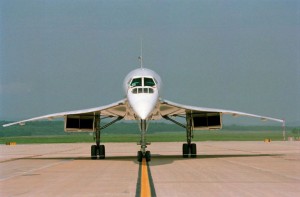Concorde: Flying Supersonic
For 27 years, the Concorde carried passengers across the Atlantic Ocean at twice the speed of sound, on the very edge of space
/https://tf-cmsv2-smithsonianmag-media.s3.amazonaws.com/filer/bd/4e/bd4e741f-94eb-40e8-be28-c2b90a7ee70e/concorde_fox-alpha_air-france.jpg)
For 27 years, the Concorde carried passengers across the Atlantic Ocean at twice the speed of sound, on the very edge of space. A flight from New York to London took a mere 3 ½ hours; the supersonic aircraft flew so high and so fast that American spyplanes were ordered to stay out of the Concorde’s way.
“It symbolized optimism; it was everything the 20th century could have stood for,” says Sir Terence Conran, one of the Concorde’s designers, in “Concorde: Flying Supersonic,” a Smithsonian Channel film.
This terrific film chronicles the race, begun during the cold war, to develop a supersonic airliner. When President John F. Kennedy called for the United States to develop an aircraft that could fly at twice the speed of sound, Boeing optimistically replied that it would design an aircraft that could take 200 passengers aloft and travel at Mach 3. (This never happened; as the Concorde's costs rose to $2 billion—$20 billion in today's dollars—Boeing turned instead to the jumbo jet, developing the 747.)
The Soviet’s Tupolev Tu-144 prototype was the first supersonic transport in the air. But the Soviets abandoned their efforts after the airplane crashed at the Paris Air Show in 1973, killing six crewmembers and eight people on the ground. After the accident, the aircraft was relegated to delivering mail; it completed just 55 passenger flights.
It took an Anglo-French alliance to develop the Concorde. On March 2, 1969, the Concorde made its maiden flight. “Our flight plan was not ambitious,” says chief test pilot André Turcat in the film. “It was simply to show it could fly.” Eight months later Turcat would take the aircraft supersonic.
The Concorde overcame a host of obstacles—high development costs, steep operating costs, and public opposition to the sonic boom. According to the film, thousands of Britons complained about the noise; one woman even alleged that the booms had made her pregnant, by interrupting her rhythm method of contraception.
By the mid-1970s, Concordes were rolling off the production lines, but without a single buyer. The French and British finally approached their own national airlines. Says Lord Heseltine, Minister for Aerospace from 1972-1974, "I had to deal with British Airways, and there's not the slightest doubt they screwed me to the floorboards."
The graceful airliner would go on to become the principal transport for the world's elite. Tune in to the Smithsonian Channel to see what ultimately grounded the Concorde.
"Concorde: Flying Supersonic" will next air on Tuesday, December 28 at 8 and 11 p.m. It is also available on demand.